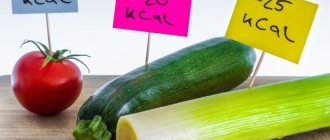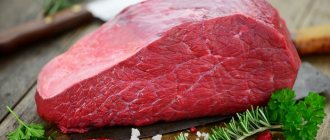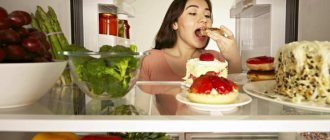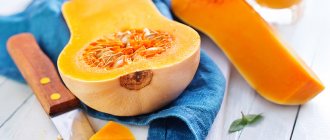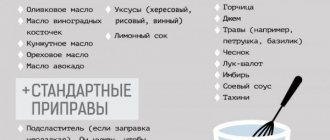One of the most correct approaches to combating excess weight is to create a diet based on low-calorie foods. It has been proven that in order to lose weight, it is not at all necessary to reduce the amount of calories consumed to a critically low level, since this can have the opposite effect and the body, sensing a threat, will completely stop consuming excess fat.
To lose weight steadily, it is enough to reduce your daily diet by 400 kcal, and at the same time eat low-calorie foods. There are special tables developed by specialist nutritionists with the energy value of foods that help you create a menu correctly and lose weight.
Are low-calorie foods always good for you?
First of all, it is recommended for people who are overweight to consume low-calorie foods. In this case, in any case, even if you are overweight, you should take into account not only the amount of energy consumed, but also the amount consumed daily. Eating low-calorie foods may not always be safe for health.
In general, it cannot be said unequivocally that foods low in calories are definitely harmful for some people and beneficial for others.
The benefits of products depend on a number of factors:
- a person’s age (over the years, fewer calories are consumed, activity decreases, and the need for large amounts of energy decreases);
- its gender (women in most cases require less high-calorie food than men);
- degree of intensity of work (when working in an office in a sitting position, you can easily gain excess weight by eating a nourishing and high-calorie diet);
- climatic zone of residence (in warm regions people intuitively prefer light food, while in cold regions the need for more filling and high-calorie food increases, which helps to retain heat longer).
All these factors significantly influence the required amount of calories that must come from food for normal human life and, as you can see, some of them may change.
Therefore, the norm for calorie needs is not static and changes when certain life circumstances change (moving to a different climate zone, changing occupation, natural aging of the body).
The benefits of low-calorie food directly depend on how well it covers a person’s energy needs. If the calories consumed are not enough for a normal existence, leading a normal lifestyle and working, then a low-calorie diet will not benefit the body, since the person will feel a constant loss of strength, weakness and malaise.
If adjusting the diet in the direction of reducing calories by including low-calorie foods in the menu does not disrupt the usual rhythm of life and the person feels normal, then there is no danger in consuming low-calorie foods in this case.
How to stay slim
Many are convinced that in order to easily lose weight, it is necessary to consume a small amount of calories or not consume them at all. This is not really a solution to the problem. Because in this case, the body receives a signal that you are “starving”, and your metabolic processes slow down. Maya Plisetskaya’s principle “you need to eat less” (sorry for the directness) does not always work - someone may misunderstand the interpretation and get into the habit of eating three fatty chops, half a loaf, or sitting on one salad dressed with a liter of mayonnaise. You definitely won’t be able to lose weight and feel good with this routine.
It would be nice to replace a “calorie bomb” like a bun with custard with a healthy human breakfast - cottage cheese with berries and herbal tea. Instead of frying meat in a frying pan, cook it in the oven or steamer. And according to Soviet canteen standards, lunch includes soup, salad and hot dishes; it is quite possible to exclude hot dishes.
Calorie content of products:
in the first course - 370 calories, 13 g of fat, in the second - 370 calories, 11 g of fat.
Let's look at examples of options for breakfast, lunch or dinner with calculating the calorie content of foods. Believe me, it is very easy to find an alternative to high-calorie and useless products!
Contraindications to a calorie deficit diet
Low-calorie foods for weight loss, a table with which will be given later in the article, can still be harmful in some cases:
- during gestation and breastfeeding;
- for hypertension;
- at the stage of recovery after undergoing surgical interventions, operations;
- during high physical activity and intensive sports;
- during the period of exacerbation of certain chronic diseases associated with the digestive tract or metabolism;
- in childhood (can lead to developmental delays, both mental and physical).
These contraindications are associated specifically with the preparation of a daily diet based exclusively on low-calorie foods. In these cases, such a diet can provoke a serious lack of important minerals, vitamins and trace elements.
Table of the lowest calorie vegetables
Low-calorie foods for weight loss, the table of which is given in the article, are associated primarily with vegetables. Many people know about the benefits of vegetables, but not everyone includes them in their diet in sufficient quantities. And it’s completely in vain, because, unlike fruits and berries, they practically do not contain sugar (with the exception of some), which significantly increases the chances of losing weight.
Low-calorie foods used in low-calorie diets for weight loss are, first of all, vegetables, some fruits and berries
In addition, vegetables are rich in a number of useful substances, which, in the absence of any genetic abnormalities in metabolism, are easily absorbed by the body. Therefore, by consuming vegetables (even low-calorie ones) in sufficient quantities, you can additionally avoid the use of synthetic vitamins and supplements.
Vegetables also contain essential antioxidants, which remove free radicals and reduce the risk of developing cancer processes in the body, and fiber, which helps to gently cleanse the body. Therefore, in addition to effective weight loss, consuming vegetables will bring enormous benefits to the entire body as a whole.
However, not all vegetables are classified as low-calorie, so you should know which of them can be consumed without fear of gaining weight, and which ones are best excluded from the diet.
| Name | Kcal (per 100 g) |
| Radish | 16 |
| Spinach | 23 |
| Asparagus | 20 |
| Cucumbers (fresh) | 14 |
| Leaf lettuce | 15 |
| Sauerkraut) | 19 |
| White cabbage) | 25 |
| Tomatoes | 20 |
| Dill | 43 |
| Broccoli | 30 |
| Carrot | 35 |
| Beetroot | 42 |
| Brussels sprouts | 43 |
| Onion | 40 |
| Parsley | 36 |
| Green peas (fresh) | 60 |
| Bulgarian pepper | 27 |
| Eggplant | 25 |
| Zucchini | 24 |
The choice of vegetables for creating a menu on a low-calorie diet is not small. Potatoes are not included in the list, since their boiled calorie content per 100 g is 82 kcal. You can sometimes include it in your diet if you wish, but you need to keep track of how many total calories you consume per day, but you are unlikely to be able to lose weight by eating only potatoes.
It is important to pay attention to the quality of the fruits, how much they are treated with pesticides and chemicals. Ideally, it is better to eat fresh vegetables from your own plot or purchase them from trusted sellers and manufacturers.
During exacerbations of gastrointestinal diseases, the consumption of vegetables must be limited (the same applies to a number of fruits and berries).
Seasonings
Red wine vinegar
3 calories per tablespoon
If you want to add fireworks of flavor to your sauce with virtually no calories, don't forget to stock your pantry with vinegars, such as red wine. Some research suggests that acetic acid may slow the digestion of food, which helps control blood glucose and increases feelings of fullness.
Advice
For a delicious salad dressing, whisk together equal parts olive oil and red wine vinegar, chopped shallots, chopped garlic, Dijon mustard, fresh thyme, salt and black pepper.
Thyme
3 calories per tablespoon
Fresh herbs like thyme, basil and dill are a great way to liven up dishes and add vibrant flavors with minimal increase in calories. Natural flavor enhancers contain an arsenal of antioxidants that will turn a low-calorie diet into an effective remedy against disease.
Fresh herbs such as thyme, basil and dill are a great way to liven up dishes and add vibrant flavors with minimal increase in calories.
Advice
Mix 1 tablespoon fresh thyme, grated zest of 1 lemon, 1 teaspoon garlic powder, ½ teaspoon smoked paprika, ½ teaspoon salt and ½ teaspoon black pepper. Rub this mixture onto chicken, steak or pork.
Cinnamon
6 calories in 1 teaspoon
When it comes to oatmeal, smoothies, or pancakes, cinnamon can help you boost flavor without the calories. A number of studies, including a recent report in Scientific Dietetics, have linked cinnamon to an improved glycemic profile, which not only reduces the risk of diabetes, but also helps achieve satiety, increase energy levels and reduce the risk of storing fat around your waist.
Advice
For a pudding that won't upset your bowels, heat 1/2 cup unsweetened almond milk in a small saucepan over medium heat until almost simmering. Remove the pan from the heat, add 85g chopped dark chocolate and 2 tablespoons unsweetened cocoa powder and leave for 5 minutes.
Stir until the chocolate has dissolved. Add 2 teaspoons grated orange zest, 1 teaspoon vanilla extract, ½ teaspoon cinnamon and a quarter teaspoon chili powder. Place chocolate mixture, 1 package silken tofu, and 2 tablespoons natural maple syrup in a blender or food processor and blend until smooth.
Refrigerate the pudding for at least a couple of hours before serving.
Table of the lowest-calorie fruits and berries
Low-calorie foods for weight loss, the table of which consists of different categories of products; in addition to vegetables, they include berries and fruits. They should become the main snacks for people who want to lose weight and adhere to a low-calorie diet and replace various types of food waste - bars, chips, candies, buns.
In addition to the fact that fruits and berries contain fructose, they, like vegetables, contain fiber, which has a beneficial effect on intestinal activity. At the same time, more fiber and beneficial microelements are contained in the peel, so it should not be removed and thrown away.
Fruits and berries help maintain a positive attitude, which is important when following dietary restrictions, and even help fight depression.
| Name of berries or fruits | Energy value, kcal per 100 g |
| blue plums | 46 |
| cherry plum (yellow, red) | 30,6 |
| lemons and limes | 10 |
| blackberry | 40 |
| cranberry | 28 |
| strawberries and wild strawberries | 33 |
| currants (red and black) | 55 |
| oranges | 75 |
| grapefruits | 42 |
| apples | 52 |
| pears | 57 |
| cherry | 50 |
| bananas | 110 |
| kiwi | 59 |
| pineapples | 48 |
| melon | 34 |
| watermelon | 30 |
Even if you adhere to a low-calorie diet, you should remember that fruit should be consumed in moderation , otherwise you may encounter allergies, stool disorders and hypervitaminosis. Also, acids contained in fruits and berries, if consumed excessively, can destroy tooth enamel and provoke the development of gastritis.
If you have problems with the gastrointestinal tract, it is better to eat fruits after heat treatment (for example, boiled and baked apples and pears).
You should also know that some fruits are very high in calories, for example, bananas, which contain 110 kcal per 100 g. In addition, the content of fruit sugars in some fruits is quite high, despite the fact that they themselves are sour (limes, lemons). Consuming them can lead to increased production of gastric juice, which in turn stimulates appetite.
Therefore, you should consume fruits and berries carefully, alternating them with each other and with other foods.
Zucchini (17cal/100g)
Light and sweet, it has been transformed from a summer vegetable into a winter vegetable thanks to the efforts of Chinese farmers. A nearly full spectrum of B vitamins will help keep you cool and sharp, while zinc and magnesium will help maintain blood sugar levels. Zucchini gives vegetable soups a puree consistency, and salads a sweetish oriental flavor. Do you know about zucchini noodles? Grate them using a Korean carrot grater and fry for two minutes until al dente. It's even tastier than homemade Italian pasta.
Table of low-calorie cereal products
Low-calorie products for weight loss, in addition to vegetables and fruits, are represented by another important category - cereals. The value of cereals is difficult to overestimate, because they are the sources of the right carbohydrates that give energy to a person, but at the same time they are not immediately deposited in problem areas of the body in the form of fat.
In addition, they contain fiber, which cleanses the intestinal walls of unnecessary waste products, which also promotes weight loss. Cereals are also rich in a number of useful components (magnesium, iron, zinc) and proteins necessary for the construction of new body cells and its restoration.
Below is a table with caloric content of various cereals:
| Name | Nutritional value per 100 g, kcal |
| oatmeal with water | 88 |
| rice porridge with water | 78 |
| pearl barley porridge on water | 97 |
| barley porridge on water | 76 |
| buckwheat porridge on water | 89 |
| quinoa on water | 120 |
| pasta (from durum wheat) | 110 |
| corn porridge on water | 60 |
Excessive consumption of cereal porridges, even with water, can lead to weight gain, so you should eat such dishes little by little without adding milk, sugar or butter. Also, some types of cereals should be treated with caution if you have digestive problems. For example, rice and buckwheat can increase constipation, while barley and oats, on the contrary, can greatly weaken the stool.
Other nutrition tips for gaining weight:
- Make yourself a meal schedule. The problem with many thin people is that they don't eat enough. A meal schedule is a huge help in gaining a certain weight, you can watch and add additional nutrition there as needed.
- Your body needs time to adjust to a more consistent eating schedule. You will snack more often, this is normal. Try to do this even if you are not very hungry.
- It is very important to drink a lot of water when you start eating more. Water helps distribute nutrients throughout the body, and weight will definitely be gained in the form of water.
Calorie table for healthy milk products
Milk and dairy products are an excellent source of protein and calcium for the body. When adhering to a low-calorie diet, you should never completely exclude dairy products from your diet, but you should choose products that are less fatty in composition.
| Name | Calorie content per 100 g, kcal |
| milk serum | 18 |
| kefir 0% | 30 |
| kefir 1% | 38 |
| kefir 1.5% | 41 |
| kefir 2.5% | 53 |
| milk 0.5% | 42 |
| milk 1% | 43 |
| milk 2.5% | 52 |
| Ryazhenka 1% | 40 |
| sour cream 10% | 119 |
| cottage cheese 0% | 71 |
| cottage cheese 2% | 103 |
| cottage cheese 5% | 121 |
| yogurt 1.5% | 52 |
If you want to lose weight, less fatty dairy products without various additives - sugar, flavorings, thickeners and fillers - will be truly beneficial for the body. Naturally leavened yoghurts and kefir are especially useful.
It is not recommended to consume completely low-fat dairy products on a regular basis, as this can impair the absorption of important microelements. Therefore, kefir and cottage cheese with zero fat content are more suitable for fasting days than for consumption during a diet.
Harm from consuming dairy products is associated with the presence of chronic diseases in which the absorption of milk protein is difficult or there is an allergy to it. Also, you should not consume a lot of whole milk in mature and old age; it is better for such people to give preference to fermented milk products.
Contraindications
Due to the presence of organic compounds that increase the acidity of gastric juice, fresh juices are contraindicated for peptic ulcers, gastritis and pancreatic diseases.
People suffering from diabetes and obesity should strictly limit the consumption of fresh orange and grape juices due to their high sugar content. To maintain immunity for such diagnoses, it is enough to consume 3-4 tablespoons of juice per day.
Low-calorie fish and seafood
Seafood and fish are an excellent source of complete and easily digestible protein that does not overload the digestive system. In addition to the fact that this category of products contains a number of important vitamins and minerals (vitamins B, E, fluorine, zinc, selenium, phosphorus), they also contain methionine, a special substance that prevents the formation of fat.
Also, fish and seafood contain very few lipids, with the exception of some varieties (eel, mackerel, sturgeon, halibut), therefore, adhering to low-calorie nutrition tactics, you should definitely include these products in your diet.
| Name | Calorie content, kcal per 100 g |
| Kelp | 25 |
| Boiled mussels | 50 |
| Boiled cod | 78 |
| Boiled pollock | 79 |
| Boiled pike | 95 |
| Boiled crabs | 96 |
| Boiled hake | 95 |
| Trout | 89 |
| Crab sticks | 95 |
| Shrimps | 99 |
| Boiled oysters | 95 |
| Zander | 97 |
| Cancers | 97 |
| Flounder | 103 |
If you follow a low-calorie diet, it is better to consume fish and seafood boiled or baked, since its calorie content increases significantly when fried. To obtain especially important Omega acids (3,6 and 9), even while adhering to a diet, you should sometimes consume fatty fish.
Low-calorie meat and eggs
In order for nutrition on a low-calorie diet to be balanced and harmonious, it is necessary to include meat and eggs in the diet. They are the most important source of protein for the human body and a number of vitamins.
However, some types of meat are very fatty and difficult for the body to digest and absorb, so if you want to lose weight, you should choose light meat, as well as offal that will not overload the digestive tract.
| The product's name | Calorie content, kcal per 100 g |
| Egg | 155 |
| Veal kidneys | 86 |
| Beef brains | 150 |
| Boiled veal | 131 |
| Chicken fillet | 165 |
| Quail egg | 158 (1 piece contains about 14 kcal) |
| Boiled beef (lean) | 158 |
| Boiled turkey | 130 |
| Beef tongue | 134 |
The preferred method of preparing meat and offal is boiling, but baking is also acceptable. When cooking, you should also not use a lot of salt, pepper and other spices.
Boiled chicken and quail eggs can be eaten as snacks. However, even light meat and offal, as well as eggs, should not be eaten for dinner.
The lowest calorie meat products
Plant foods are good for weight loss, but you should not exclude meat products from your diet.
You may be interested in How to use the Bormenthal food calorie table?
A long-term absence of meat in the diet of a losing weight person threatens the lack of useful substances in the body that are not found in plant foods.
Proteins, which come from meat products, constitute an important component in muscle building. Thanks to the work of muscles, physical activity allows us to burn the required amount of calories.
The body will spend more energy burning proteins rather than digesting fats and carbohydrates.
When choosing meat, you should give preference to rabbit meat, lean cuts of veal and beef, and white poultry meat. The listed products are quite filling. Their calorie content is as follows:
- Lamb kidneys – 77 kcal;
- Beef – 187 kcal;
- Beef udder, brains, kidneys, heart, tongue - 173/124/66/87/163 kcal;
- Turkey – 197 kcal;
- Horsemeat – 143 kcal;
- Rabbit – 199 kcal;
- Chicken – 165 kcal;
- Pork liver, kidneys, heart – 108/80/89 kcal;
- Veal – 90 kcal;
- Chicken – 156 kcal.
Foods with “negative” calorie content
Foods with a negative calorie content include those for which the body spends more calories to digest than it takes in. Such products help fight excess weight and also prevent it from gaining in the future.
These include:
- leaf lettuce (cress, lettuce);
- cucumbers;
- white radish;
- tomatoes (yellow, red, brown);
- grapefruit;
- broccoli;
- celery.
Previously, these products were listed in the table of low-calorie vegetables and fruits, but their nutritional value is so low that many nutritionists classify these products as foods with “negative” energy value.
Examples of compatible products that can be mixed
Low-calorie foods for weight loss, the table with which was given in the article, in many cases can be perfectly combined with each other, making it possible to lose weight and eat a varied diet. This, in fact, is the advantage of a low-calorie diet, in contrast to fasting or mono-diets, which involve strict restrictions.
It is only important to competently approach the preparation of the menu and know which products are “friendly” with each other.
To do this, you should know the basic principles of creating a diet, which will be useful not only at the stage of losing weight, but also in the future:
- boiled or baked fish goes well with vegetables in any form (boiled, baked, fresh);
- meat can also be successfully garnished with vegetables prepared at your discretion (for example, with boiled turkey you can serve a fresh salad of tomatoes and cucumbers or baked bell peppers, pumpkin and eggplant);
- Milk should be consumed carefully, without mixing it with other products, with the exception of honey, cinnamon, vanilla and dried fruits;
- melon and watermelon should also be eaten separately, after a break of at least 60 minutes after eating;
- You should not combine meat and eggs in one dish, as together these products will have high nutritional value;
- Cottage cheese, as well as kefir and yogurt, are successfully combined with berries or fruits. These options are perfect for breakfast or can be used as a snack;
- fresh vegetables and herbs can be served with seafood;
- It is better to eat cereal porridges for breakfast, adding slices of fruit and berries to them.
What to eat without harming your figure? 10 delicious low-calorie dishes, recipes
To eat tasty and healthy at home, you don’t have to order delivery of PP lunches or stand at the stove for several hours, before doing a shopping raid in search of exotic ingredients. We invite you to diversify your diet without harming your figure with the help of recipes published on the Grand Culinary website. Their preparation will take no more than an hour, and the calorie content of each dish is from 66 to 490 calories. Our selection includes salads, soups, vegan side dishes and even desserts.
Pork tenderloin baked in spices
In one serving:
209 calories.
Cooking time:
35 minutes.
Ingredients for 4 servings:
- 600 g pork tenderloin;
- 1 tbsp. olive oil;
- 1 tsp chopped garlic;
- 1 tsp garlic powder;
- 1 tsp dried oregano;
- 1 tsp ground cumin;
- 1 tsp ground coriander;
- 1 tsp dried thyme;
- salt.
Mix the dry ingredients in a bowl until the seasoning is smooth. Using dry hands, sprinkle it over the tenderloin, then rub the spices into the sides of the meat, pressing gently.
Preheat the oven to 230 degrees. In a large frying pan over medium heat, heat the olive oil and fry the minced garlic for a minute, stirring. Place the tenderloin in the pan and sear for 10 minutes, browning the meat on each side. Use tongs to turn the meat over. Transfer the tenderloin to a baking dish and place in the oven for 20 minutes. Before serving, cut into medallions.
5 low-calorie cocktails for a home party that won't harm your figure
These recipes will allow you to continue losing weight without leaving the team.
Salmon with tomatoes baked in foil
In one serving:
300 calories.
Cooking time:
40 minutes.
Ingredients for 4 servings:
- 4 salmon fillets, 140 g each;
- 3 tbsp. olive oil;
- 3 chopped tomatoes;
- 2 shallots, chopped;
- 2 tbsp. fresh lemon juice;
- 1 tsp dried oregano;
- 1 tsp dried thyme;
- salt and ground black pepper to taste.
Preheat the oven to 205 degrees. Drizzle the fish with 2 teaspoons olive oil, pepper and salt. In a bowl, combine tomatoes, shallots, 2 tablespoons oil, lemon juice, oregano, thyme, salt and pepper.
Place the salmon fillets on a sheet of foil, buttered side down, and twist the ends of the foil into a spiral. Spread the tomato mixture over the fish. Cover the dish completely with the edges of the foil and place the parcels on a baking sheet. Bake until done, about 25 minutes.
Photo: istockphoto.com
American pasta salad
In one serving:
286 calories.
Cooking time
: 30 minutes.
Ingredients for 6 servings:
- 2 cups cooked and washed pasta cones;
- 1/3 cup chopped celery stalk;
- 1/4 cup chopped red onion (soak in water for 5 minutes);
- 1 tbsp. chopped parsley;
- 1/2 cup cherry tomatoes (optional);
- 1/2 cup mayonnaise;
- 3/4 tsp. dry mustard;
- 1.5 tsp. Sahara;
- 1.5 tbsp. apple cider vinegar;
- 3 tbsp. sour cream;
- salt, freshly ground pepper to taste.
In a large bowl, combine pasta, celery, onion, parsley and tomatoes. In a small bowl, mix mayonnaise, mustard, sugar, vinegar, sour cream and salt. Season the salad with sauce, salt and pepper.
Perfect morning: 7 best weekend breakfasts
Healthy and beautiful recipes for those who don’t need to rush anywhere.
Tuscan vegetable soup with beans and spinach
In one serving:
145 calories.
Cooking time:
35 minutes.
Ingredients for 6 servings:
- 1 can of canned white beans (drain liquid, rinse beans);
- 1 tbsp. olive oil;
- 1 cup diced onion;
- 1/2 cup diced carrots;
- 1/2 cup diced celery stalk;
- 1.5 cups diced zucchini;
- 1 chopped garlic clove;
- 1 tsp dried thyme;
- 1/2 tsp. dried sage;
- 1/2 tsp. salt;
- 1/4 tsp. freshly ground black pepper;
- 0.9 liters of lightly salted chicken or vegetable broth;
- 1 can of tomatoes in pieces without salt;
- 2 cups chopped spinach leaves;
- 1/3 cup grated Parmesan.
Mash half the beans in a bowl with a potato masher or spoon. In a large saucepan, heat the oil over moderate heat and add the onion, carrots, celery, zucchini, garlic, thyme, sage, salt and pepper. Cook for about five minutes until the vegetables are soft, stirring occasionally.
Add broth and tomatoes with juice to the pan and bring to a boil. Add the pureed and whole beans and spinach and cook for about three minutes until the spinach is wilted. Serve sprinkled with Parmesan cheese.
Photo: istockphoto.com
Beef with vegetables
In one serving:
450 calories.
Cooking time:
30 minutes.
Ingredients for 4 servings:
- 700 g machete steak;
- 170 g fresh mushrooms, sliced;
- 110 g green peas or green beans;
- 1 can young corn cobs, drained;
- 1 thinly sliced red bell pepper;
- 1/4 cup soy sauce;
- 1 chili pepper, seeded and finely chopped;
- 2 tsp Sahara;
- 2 tbsp. lime juice;
- 2 tbsp. olive oil;
- 2 cloves of garlic, grated;
- 1 bunch of thinly sliced green onions;
- salt and ground black pepper.
Cut the meat lengthwise into pieces 10 cm long, then across the grain into slices 0.6 cm thick, season with salt and pepper. In a bowl, mix soy sauce, chili pepper, sugar and lime juice. Stir until the sugar dissolves. Add the beef to the sauce, stir to coat the meat with liquid.
Heat olive oil in a large skillet over moderate heat, add beef and cook for 3-5 minutes, stirring. Remove meat and set aside. Let the liquid in the pan thicken, about 4 minutes. Add garlic and green onions, cook for another minute. Add mushrooms, cook for 2-3 minutes. Add snow peas or beans, corn on the cob, and bell pepper and continue cooking until vegetables are crisp-tender, about 2 minutes. Add the meat to the pan and stir.
How to eat less and not be hungry. 10 tricks to trick your brain
You won't have to suffer.
Roasted Cauliflower
In one serving:
66 calories.
Cooking time:
20 minutes.
Ingredients for 4 servings:
- 1 head of cauliflower;
- 2 tsp vegetable oil;
- 2 cloves garlic, minced;
- 2 tbsp. soy sauce;
- juice of a whole lime (or a little rice vinegar);
- 2 chopped green onions;
- 1 tbsp. sriracha sauce or other hot sauce;
- lime wedges for garnish.
Break the cauliflower into large florets, then use your hands to tear them into very small pieces. Heat a large heavy-bottomed frying pan over medium-high heat, add the vegetable oil, then the cauliflower and garlic. Fry, stirring, until the cabbage becomes very crispy in places. Cook for 3 minutes, then reduce heat.
Add the soy sauce, lime juice and most of the green onions, stir and cook for a minute, then pour in the hot sauce and stir. Add a little more sauce if you prefer deeper color and flavor. Serve the cabbage hot, top with the remaining onions and garnish with lime wedges.
Photo: istockphoto.com
Chowder with broccoli and cheddar cheese
In one serving:
200 calories.
Cooking time:
40 minutes.
Ingredients for 6 servings:
- 350 g of concentrated milk;
- 1 head of broccoli;
- 1 finely chopped small onion;
- 1 medium red potato, diced;
- 1/4 cup flour;
- 3 cups chicken or vegetable broth;
- 1/4 tsp. fresh grated nutmeg;
- 1 cup shredded sharp cheddar;
- 1 tsp Worcestershire sauce;
- salt and pepper;
- 2 green onions, thinly sliced into rings.
Separate the broccoli buds from the stem: chop the large ones, set aside the small ones for decoration. Peel the stem and chop finely.
Fry the onion, potatoes and broccoli stalk over moderate heat, stirring, for 7-10 minutes. Add flour and fry for 2 minutes. Pour in the broth and bring to a boil. Reduce heat and simmer, stirring occasionally, until vegetables thicken and soften - 12-15 minutes.
Place small broccoli buds in a saucepan and add 1/2 cup water and bring to a boil. Cover and cook until tender, about five minutes. Mix all ingredients in a saucepan, remove from heat, add salt and pepper to taste, sprinkle with green onions on top.
Q&A: Why do runners eat pasta the night before a race?
We tell you what kind of pasta there is, why and where to find it.
Fettuccine Alfredo
In one serving:
490 calories.
Cooking time:
25 minutes.
Ingredients for 4 servings:
- 15 g butter;
- 1 finely chopped garlic clove;
- 1 tsp grated lemon zest;
- 2 tsp wheat flour;
- 1 glass of 2% milk;
- 2 tbsp. soft cheese;
- 3/4 cup grated Parmesan;
- 3 tbsp. chopped fresh parsley;
- 340 g fettuccine;
- salt and pepper.
To prepare the sauce, place a frying pan over medium heat, melt the butter, fry the garlic and lemon zest for a minute. Add flour and stir constantly for about 3 minutes until the sauce begins to thicken. Add both cheeses and continue stirring for about a minute until melted. Throw in the parsley.
At the same time, cook the pasta in salted boiling water for 2-3 minutes until half cooked. Pour a glass of water from the pan into a separate bowl, drain the remaining liquid. Add the sauce, half a cup of the remaining cooking water and salt to taste to the pan with the pasta, stir gently. Add parmesan and freshly ground pepper to pasta bowls.
Photo: istockphoto.com
Frozen berry smoothie
In one serving:
366 calories.
Cooking time:
5 minutes.
Ingredients for 2 servings:
- 1 frozen banana, peeled and chopped;
- 2 cups frozen strawberries, raspberries or cherries;
- 1 glass of milk;
- 1/2 cup plain or vanilla yogurt;
- 1/2 cup freshly squeezed orange juice;
- honey to taste.
Place all ingredients in a blender and grind until smooth, pour into glasses.
If there is no summer: 5 simple recipes to replenish your vitamin supply
Smoothie. A healthy and satisfying snack in one glass. Infographics with recipes.
Whole wheat cake
In one serving:
254 calories.
Cooking time:
1 hour.
Ingredients for 8 servings:
- 1.5 cups white whole grain flour;
- 2 tsp baking powder;
- 1/4 tsp. fine salt;
- 3/4 cup sugar;
- finely grated zest of 1 lemon;
- 1/2 cup plain Greek yogurt 2%;
- 1/4 cup milk 1%;
- 1/4 cup olive oil;
- 1/2 tsp. vanilla extract;
- white of 2 large eggs;
- 1 large egg.
Preheat the oven to 175 degrees. Spray a 21x11cm loaf pan with cooking spray. In a bowl, whisk together the flour, baking powder and salt. In another bowl, combine the sugar and lemon zest and rub it in with your fingers. Add yogurt, milk, olive oil, vanilla, egg whites and whole egg and beat vigorously until thoroughly combined. Add the flour mixture to the liquid mixture and mix thoroughly.
Pour the batter into the pan and bake for about 50 minutes. Cool the cake on a wire rack for five minutes, then turn it out and cool to room temperature.
